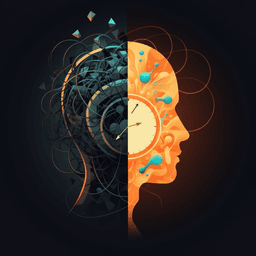
Health and Fitness
Time of day and sleep effects on motor acquisition and consolidation
C. Truong, C. Ruffino, et al.
Discover how the time of day influences motor skill acquisition and consolidation in a finger-tapping task. This innovative study, conducted by Charlène Truong, Célia Ruffino, Jérémie Gaveau, Olivier White, Pauline M. Hilt, and Charalambos Papaxanthis, reveals that evening training enhances skill retention, thanks to the pivotal role of sleep.
~3 min • Beginner • English
Introduction
The study examines whether the time of day at which practice occurs influences motor skill acquisition (within-session improvement) and consolidation (offline change measured later), and whether sleep mediates these effects. Prior research shows motor performance fluctuates across the day with circadian rhythms, often favoring late afternoon/evening, and sleep is known to facilitate consolidation of motor skills. However, the optimal time-of-day for motor learning and the specific impact on acquisition versus consolidation remain unclear, with mixed findings and confounds between sleep and time-of-day. The authors hypothesized that both acquisition and consolidation might be better in the afternoon than the morning, motivated by daily modulation of neurophysiological mechanisms (e.g., cortisol’s influence on LTP-like plasticity in M1 and hippocampal activation). They designed a main experiment with morning, afternoon, and evening practice groups, and two control experiments to isolate sleep effects on consolidation.
Literature Review
Evidence shows circadian influences on motor and cognitive performance, with better strength and skilled performance typically in late afternoon/evening versus morning (e.g., maximal voluntary contraction, speed–accuracy tradeoff, handwriting, tennis/badminton performance). Findings about time-of-day effects on motor learning are mixed: some report no differences between morning and evening training, while others suggest time-of-day modulates expression of learning; many prior studies confounded sleep with time-of-day. Sleep is widely implicated in motor sequence consolidation (offline gains), with sleep-stage correlates (notably NREM2 spindles) and a favorable molecular/cellular environment for plasticity. Neurophysiological processes relevant to learning (LTP-like plasticity, intracortical inhibition in M1) and hormones (cortisol) vary across the day and may influence consolidation. Competing memory systems (procedural and declarative) and potential interference also affect consolidation and may depend on timing and cortisol levels. Gaps remain regarding whether consolidation benefits depend on proximity of training to sleep and how nap opportunities or chronotype moderate effects.
Methodology
Design: Main experiment with three groups trained at different times of day on Day 1 and retested 24 h later (Day 2): G10am (10:00), G3pm (15:00), G8pm (20:00). Two control groups trained at 20:00: G8sleep retested at 10:00 next day (~14 h later; 2 h after waking), and G8awake retested 2 h later the same evening at 22:00 (before sleep). Participants: 59 healthy right-handed adults (1 excluded prior to analysis). Main experiment: n=36 (G10am n=12, 8F, 25±6 y; G3pm n=12, 7F, 24±6 y; G8pm n=12, 6F, 23±2 y). Controls: G8sleep n=12 (5F, 23±4 y), G8awake n=11 (4F, 26±3 y). Exclusion: musicians/professional typists. Chronotype (MEQ) and sleep quality (PSQI) assessed; groups did not differ. Procedure: Sequential finger-tapping task with non-dominant hand on keyboard performing sequence 1-4-2-3-1-0; one trial = six sequences continuously. Participants completed 48 trials on Day 1 (12 blocks of 4 trials; 5 s inter-trial, 30 s inter-block). T1 (pre-test) = trials 1–2; T2 (post-test) = trials 47–48; training trials = 3–46 (n=44). Retest T3: two trials. G10am, G3pm, G8pm retested 24 h later; G8sleep retested 14 h later at 10:00; G8awake retested 2 h later at 22:00. Vision of the hand occluded; sequence visible; no feedback on performance. Measures: For each trial, movement duration (s) and error rate (errors out of 6 sequences; expressed as percentage) computed. Composite skill metric (arbitrary units): Skill = 1 − (number of errors)/duration; increases reflect improved speed and/or accuracy. Gains: Acquisition gain = (T2−T1)/T1 × 100; Consolidation gain = (T3−T2)/T2 × 100. Learning curves: Trial-by-trial skill (48 trials) fit with power law Skill = a·Trial^b; learning rate b compared between groups. Asymptote estimation via derivative thresholding at multiple thresholds. For G8pm, extrapolated predicted skill to trials 49–50 (T3pred) to estimate T2–T3pred gain and compare to observed T2–T3 to test for offline learning vs continued practice. Statistics: Normality (Shapiro–Wilk) and sphericity (Mauchly) checks. rmANOVA for Skill with Group (between: G10am, G3pm, G8pm) × Session (within: T1, T2, T3). One-way ANOVAs for gains between groups; post hoc Newman–Keuls. One-sample t-tests comparing gains to zero. Error rate analyzed with permutation tests (5000 permutations) and FDR correction. Independent t-tests to compare G8pm vs G8pred, and to compare control groups’ gains vs G8pm. Effect sizes: partial η² (ANOVA) and Cohen’s d (t-tests). Bayesian equivalence analyses employed when appropriate (ROPE = [−0.1, 0.1], Cauchy prior 0.707). Ethics: approved by regional ethics committee; participants refrained from drugs/alcohol/intense activity; maintained typical sleep-wake schedules.
Key Findings
Acquisition: All main-experiment groups showed significant within-session skill improvement (T1→T2): G10am t=6.71, p<0.001, d=1.94; G3pm t=5.87, p<0.001, d=1.69; G8pm t=9.03, p<0.001, d=2.61. Learning curves fitted by power functions did not differ between groups (learning rate b: F2,33=0.54, p=0.54; Bayesian equivalence supported null). The trial at which performance approached asymptote did not differ (G10am 26±5; G3pm 27±3; G8pm 27±3; F2,33=0.37, p=0.69; Bayesian equivalence supported null). Consolidation (T2→T3): Group differences emerged. Post hoc comparisons showed deterioration for G10am (T2 vs T3 p=0.03), stabilization for G3pm (p=0.71), and improvement for G8pm (p=0.02). One-way ANOVA on T2–T3 gains: F2,33=7.44, p=0.002, η²=0.32; G10am differed from G3pm (p=0.01) and G8pm (p=0.002). Gains vs zero: G10am deterioration t=2.27, p=0.04, d=0.66 (9/12 decreased); G3pm no significant change t=1.49, p=0.17, d=0.43 (8/12 increased); G8pm improvement t=3.02, p=0.01, d=0.87 (12/12 increased). For G8pm, observed T2–T3 gain exceeded predicted continuation (T2–T3pred) based on extrapolated learning: t=2.21, p=0.04, d=0.90, indicating offline learning rather than mere continued practice. Despite differences in offline changes, all groups showed T1→T3 improvements (p<0.001). Control experiment 1 (G8sleep, 20:00 training; 10:00 next-day retest, ~14 h, 2 h after wake): rmANOVA session effect F2,22=65.25, p<0.001, η²=0.85; T1–T2 acquisition significant (t=6.07, p<0.001, d=1.75) and comparable to G8pm (t=0.07, p=0.94). T2–T3 offline gain significant (t=4.44, p<0.001, d=1.28), not different from G8pm (t=−0.18, p=0.86), and greater than G10am (t=3.80, p<0.001, d=1.74). Control experiment 2 (G8awake, 20:00 training; 22:00 retest, +2 h awake): rmANOVA session effect F2,20=25.56, p<0.001, η²=0.72; T1–T2 acquisition significant and comparable to G8pm (t=−0.16, p=0.86). No significant T2–T3 gain after 2 h (t=−1.07, p=0.31), and significantly less than G8pm’s offline gain (t=−2.99, p=0.007, d=1.25). Overall: Acquisition is independent of time-of-day, whereas consolidation depends on training time; sleep, not mere time awake, underlies the offline improvement when training occurs close to sleep (evening).
Discussion
The study demonstrates that while motor skill acquisition during practice is unaffected by time-of-day, consolidation is time-dependent: morning training is followed by deterioration, afternoon by stability, and evening by improvement after 24 h. Control experiments show that the offline gain after evening training is attributable to the night of sleep rather than continued practice, time elapsed before sleep, or the duration awake after sleep. These findings refine understanding of when sleep benefits motor memory: a temporal window close to sleep appears optimal for stabilizing and enhancing newly formed motor memories. Potential mechanisms include circadian modulation of neurophysiology (e.g., cortisol rhythms that affect LTP-like plasticity and hippocampal engagement), reduced retroactive interference when sleep follows training sooner, and interactions between procedural and declarative memory systems that may be more favorable near sleep. The results have practical implications for scheduling practice in sports and rehabilitation, suggesting evening sessions may yield better retention. The findings also motivate mechanistic studies to disentangle contributions from cortico-striatal/cerebellar networks, M1 plasticity, sleep architecture, and the role of explicit/implicit learning components.
Conclusion
Training time-of-day selectively influences motor memory consolidation but not acquisition: evening practice proximal to sleep produces robust offline gains, whereas morning practice away from sleep can lead to forgetting. Two control experiments confirm that sleep—rather than mere passage of time or time awake—drives the observed consolidation benefits when training is close to bedtime. These insights can inform the scheduling of practice in sports, clinical rehabilitation, and experimentation. Future research should: (1) quantify sleep architecture to link specific stages (e.g., NREM2, spindles) with time-of-day effects; (2) test nap designs (e.g., post-morning training naps) to probe the proximity-to-sleep hypothesis; (3) dissect explicit vs implicit learning contributions and associated neural circuits across the day; (4) examine hormonal/circadian mechanisms (e.g., cortisol) and M1/hippocampal dynamics; (5) expand samples across chronotypes and ages and increase sample sizes to improve generalizability.
Limitations
Sleep was not quantified polysomnographically; only self-reported sleep quality (PSQI) was assessed. Sample sizes per group were modest, potentially limiting detection of small effects. The majority of participants were intermediate chronotypes, constraining generalizability to other chronotypes. The composite skill metric, while addressing speed–accuracy tradeoffs, may obscure distinct changes in speed versus accuracy; error rate analyses required nonparametric methods. Learning components (implicit vs explicit) and neural correlates were not isolated. Although T3pred extrapolation argues against continued practice, some improvement could reflect dissipation of reactive inhibition. The study used a single task (non-dominant-hand finger-tapping) and specific training/retest intervals; results may not generalize to other tasks or schedules.
Related Publications
Explore these studies to deepen your understanding of the subject.







